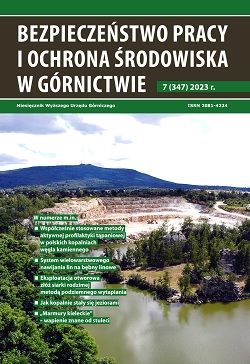
- Contemporary methods of active rock burst prevention in Polish hard coal mines
Hard coal mining in Poland is accompanied by the risk of rock bursts. The developed methods of preventing this threat effectively reduce the frequency of rock bursts and minimize the effects of tremors. The article characterizes the scope of application of individual methods of active rock burst prevention in the years 2017-2021. The analysis of the collected data shows that in mining practice, methods aimed at disintegrating the rock environment in the vicinity of endangered excavations with the use of explosives are mostly used (mainly torpedo shooting and concussion shooting).
- Multi-layer winding system for rope drums
Mining shaft hoists are relatively rarely equipped with hoisting machines with drums with multi-layer winding of ropes. In order to eliminate the possibility of jamming of the rope during such winding, eg "LEBUS" linings with parallel grooves of the drum along a part of its circumference with two diagonal passages are used. This system ensures that the rope is wound up and unwound smoothly, in a way that increases its durability by up to four times. Improper installation of liners with parallel and diagonal grooves may, however, lead to the destruction of the rope. Their correct installation is one in which the miter groove zones must be opposite each other, and all wedges must be properly made and mounted. Drum machines with multi-layer winding require the use of special constructions of steel ropes. Ropes with high transverse stiffness, based on IWRC steel cores or plastic cores resistant to transverse deformation, are preferred. All conditions for use on the drum of a machine with a "LEBUS" lining are met by 34 x 7-FC or 35 x 7-WSC construction ropes, as well as NOTORPLAST construction ropes and Turboplast ropes.
- Borehole mining of native sulfur deposits by underground smelting
In the Polish lands, sulfur was already known in the 10th century. The first place of its extraction was found in the area of Swoszowice near Kraków. In the years 1415-1921, there were four sulfur mining centers in Poland, the total production of which is estimated at about 200,000 tons. After World War II, the exploration led to the discovery of sulfur deposits in the Tarnobrzeg region. As a result, in the "Grzybów" mine, among others, mining of sulfur was started (in 1966) by underground smelting, using the Frasch method adapted to seabed deposits. In this method, the construction of a production well consists of five elements: casing columns: initial and technical, and production columns: water, sulfur and air. The water column pumps process water at a temperature of about 160°C under a pressure of 0.8-0.9 MPa. The sulfur column receives melted sulfur at a temperature of 140-150°C. The production wells are drilled in a triangular grid of 45 x 45 m and - in the case of re-mining - 45 x 60 m. The main criterion in determining the reservoir depressurization index is to maintain a balance between the reservoir pressure and the pressure generated by the overburden rocks. For the Osiek mine, the depressurization rate should be within the range of 35-70% of the amount of water injected into the deposit.
- How mines became lakes
- "Kielce Marbles" - limestone known for centuries
Bezpieczeństwo Pracy i Ochrona Środowiska w Górnictwie (Work Safety and Environmental Protection in Mining) - the whole list







